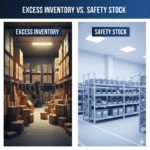During Holidays, for many businesses, it’s the busiest time of the year. To make the most of this period and avoid any stockouts or overstocking issues, it’s crucial to take a proactive approach to inventory management. Whether you’re a retailer or an e-commerce business owner, understanding how to adjust inventory levels, forecast demand, and optimize stock will help you navigate the holiday rush smoothly. In this guide, we’ll provide essential tips to ensure your inventory is holiday-ready.
1. Understand the Importance of Inventory Forecasting
Inventory forecasting is the backbone of holiday sales planning. Properly forecasting demand helps you avoid both stockouts and overstocking, ensuring you have just enough inventory to meet customer needs without tying up too much capital in unsold products.
Tips for effective inventory forecasting:
- Analyze past data: Review sales data from previous holiday seasons to identify trends. Look for patterns based on factors like product categories, time of year, and promotional activities.
- Use advanced tools: Leverage inventory forecasting tools or software that can predict demand more accurately based on various factors like market trends, weather, and consumer behavior.
- Consider external factors: Don’t forget to account for external variables such as shipping delays, supplier issues, or changes in consumer habits due to economic factors or unforeseen events.
By effectively forecasting your inventory needs, you can ensure that you have enough products to meet demand without overstocking, which can lead to unnecessary markdowns after the holiday rush.
2. Adjust Your Inventory Levels in Advance
With the surge in holiday sales, it’s essential to adjust your inventory levels well before the peak season starts. This involves planning for an increase in demand while maintaining optimal stock levels to avoid excess inventory that could affect your cash flow.
Steps to adjust inventory levels:
- Review your current stock: Conduct a thorough audit of your existing inventory. Identify slow-moving products that might not sell well during the holiday season and consider liquidating or discounting them before the rush.
- Increase orders for popular items: Based on your forecast, increase orders for the items you expect to be in high demand. Consider working with your suppliers to ensure they can handle larger orders and deliver on time.
- Utilize safety stock: Safety stock acts as a buffer to cover unexpected demand spikes. It’s essential to calculate the right amount of safety stock for each product, ensuring you can handle unforeseen surges in sales without running out.
By making early adjustments, you can avoid last-minute scrambling and ensure that you’re well-prepared for the busy season.
3. Optimize Stock for High-Demand Products
Not all products are created equal when it comes to holiday sales. Some items will experience a significant uptick in demand, while others might not see as much action. Optimizing your stock for these high-demand products is crucial to ensuring you don’t miss out on sales.
Tips for optimizing stock:
- Focus on bestsellers: Identify your top-performing products and make sure you have an ample supply to meet the increased demand during the holidays. If you’re unsure, look at sales trends from previous years and customer preferences to make informed decisions.
- Leverage promotions and bundles: During the holiday season, offering discounts, limited-time promotions, or product bundles can help move excess stock while boosting overall sales. Tailor these strategies to products that are easier to sell in bundles.
- Diversify your product offerings: If you’re noticing that one particular product is likely to sell out quickly, consider diversifying your stock with complementary items that could catch the interest of customers still looking for a gift.
By optimizing your stock, you can maximize sales and keep your customers happy by having the products they want in stock.
4. Manage Your Suppliers and Logistics
A key part of preparing your inventory for the holiday season is making sure your suppliers and logistics partners are on the same page. With higher demand during the holidays, delays in shipping or supply chain disruptions can result in missed sales opportunities and lost revenue.
Tips for managing suppliers and logistics:
- Negotiate with suppliers early: Reach out to your suppliers well in advance to discuss your projected inventory needs. By building a strong relationship, you can negotiate favorable terms and ensure priority treatment during peak season.
- Plan for shipping delays: As holiday shipping can get congested, work with logistics providers who can guarantee faster shipping times or offer expedited services. Make sure your customers are aware of potential delays and offer solutions like expedited shipping if needed.
- Stock strategically across multiple locations: If you run an e-commerce store, consider warehousing stock in different locations to cut down on shipping times and costs during peak season. This can also help you handle demand spikes in specific regions.
Effective supplier and logistics management will help ensure that your inventory is always stocked and ready to meet customer expectations.
5. Consider Using a Liquidation Strategy
If you’re finding that some of your stock isn’t moving as quickly as expected or you’re concerned about carrying too much inventory into the new year, consider using a liquidation strategy. Liquidating products that aren’t expected to sell can help you free up space for new merchandise and recover some of your investment.
How liquidation can help:
- Sell off slow-moving stock: Liquidation can help you get rid of unsold or slow-moving inventory without resorting to heavy discounts.
- Recover capital: Instead of letting dead stock gather dust, you can recoup some of your money by selling at a discounted price to liquidation buyers or liquidators, who will handle the resale process.
- Free up storage space: Liquidating excess inventory can create more room for fresh stock and products that will generate better holiday sales.
If you choose to use liquidation, make sure to work with a trusted partner to ensure that the process is smooth and doesn’t negatively affect your brand’s reputation.
6. Monitor and Adjust Your Inventory During the Holiday Season
Even with the best preparation, the holiday rush can sometimes bring unforeseen challenges. Monitoring your inventory throughout the season and making adjustments as needed can help you stay ahead of demand and prevent stockouts or overstocking issues.
How to monitor inventory effectively:
- Use inventory management software: Modern inventory management systems can provide real-time tracking of stock levels, allowing you to quickly identify which products are selling well and which are lagging behind.
- Monitor sales trends regularly: Keep an eye on your sales performance throughout the holiday season. If a product is selling faster than anticipated, consider placing a reorder to avoid running out of stock.
- Be ready to adapt: Stay flexible with your plans and be ready to make changes if something isn’t working. Whether it’s adjusting prices, promoting different products, or shifting your inventory priorities, quick decision-making is key to holiday success.
Conclusion
The holiday rush is an exciting time for businesses, but it also comes with its own set of challenges. By adjusting your inventory levels, forecasting demand, and optimizing stock for high-demand products, you can make the most of the season. Additionally, managing suppliers, considering liquidation strategies, and staying on top of inventory during the holidays will help you stay organized and efficient. With these tips in mind, you’ll be well on your way to maximizing sales and delivering an exceptional customer experience this holiday season.
Happy holidays and successful selling!







